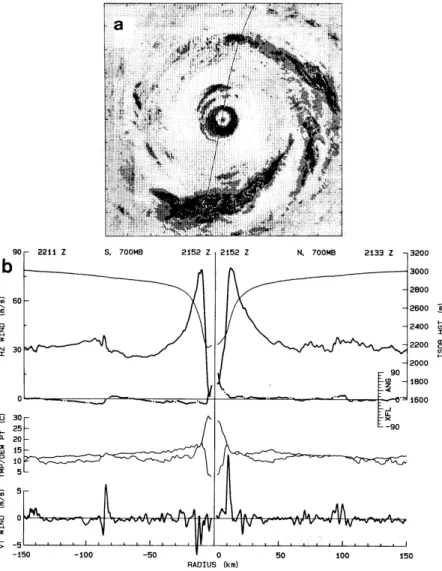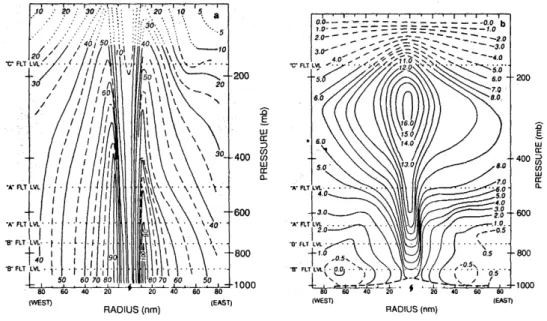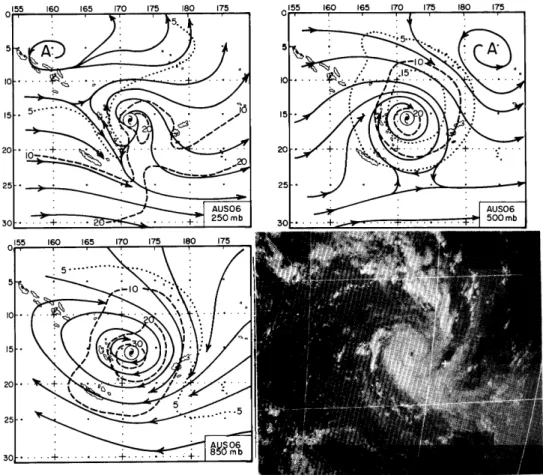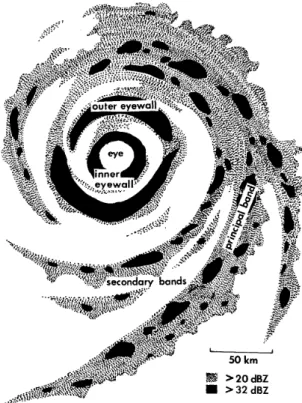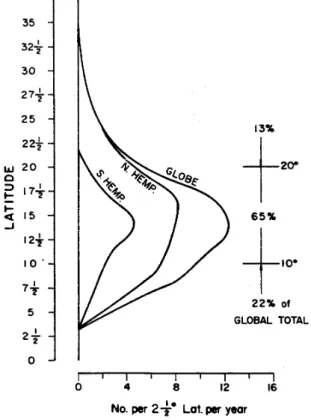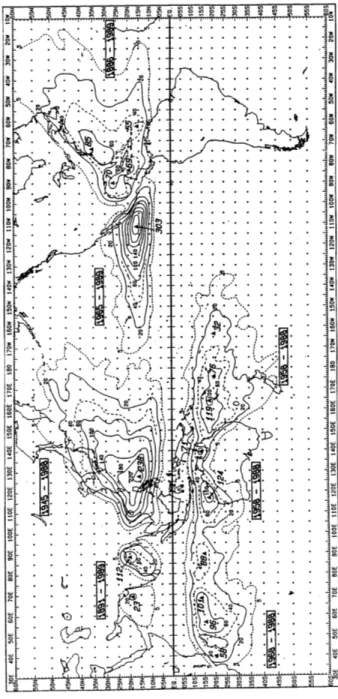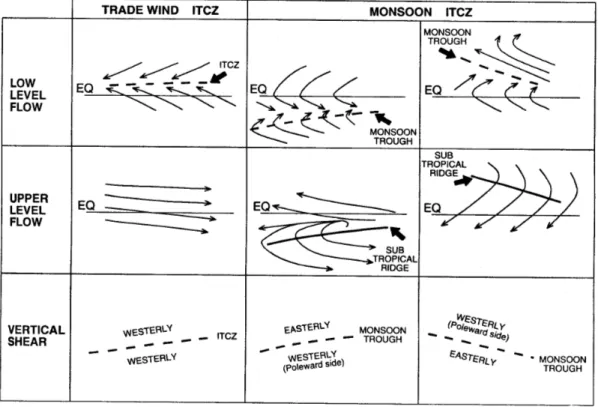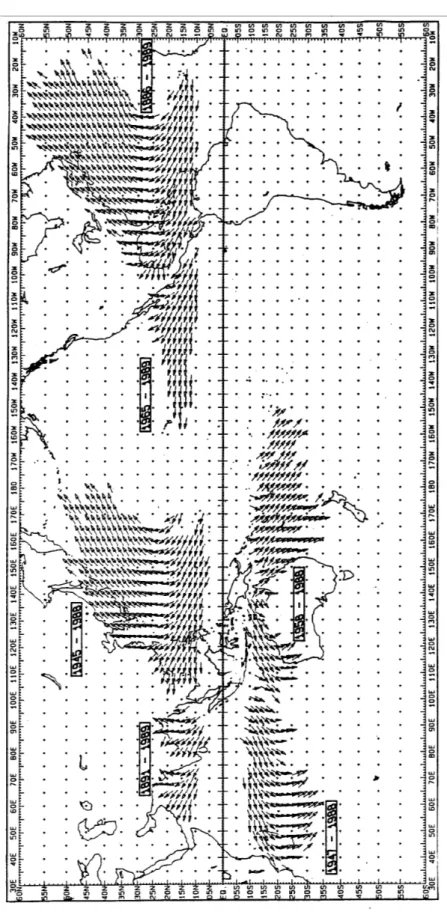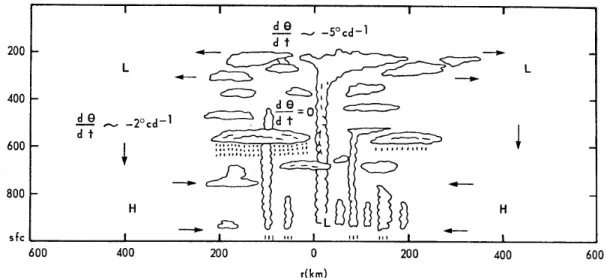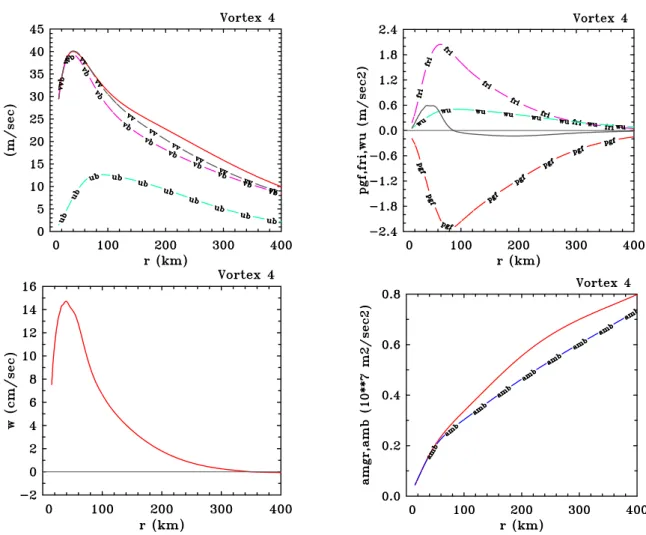CYCLONES
Roger K. Smith
Date: June 2, 2006
Contents
1 OBSERVATIONS OF TROPICAL CYCLONES 5
1.1 Structure . . . . 5
1.1.1 Precipitation patterns, radar observations . . . . 9
1.1.2 Wind structure . . . . 11
1.1.3 Thermodynamic structure . . . . 11
1.1.4 Vertical cross-sections . . . . 12
1.1.5 Composite data . . . . 15
1.1.6 Strength, intensity and size . . . . 15
1.1.7 Asymmetries . . . . 17
1.2 Formation regions . . . . 19
1.2.1 Large-scale conditions for formation . . . . 26
1.3 Tropical-cyclone tracks . . . . 27
2 DYNAMICS OF MATURE TROPICAL CYCLONES 30 2.1 The primary and secondary circulation . . . . 30
2.2 The equations of motion . . . . 30
2.3 The primary circulation . . . . 32
2.4 The tropical-cyclone boundary layer . . . . 34
2.5 Moist convection and the sloping eyewall . . . . 36
2.6 Buoyancy and generalized buoyancy . . . . 37
2.7 The tropical cyclone eye . . . . 40
2.8 Radiative cooling . . . . 41
2.9 Tropical cyclone intensity change . . . . 43
2.10 The secondary circulation . . . . 43
2.10.1 Ertel PV and the discriminant . . . . 47
2.10.2 The forcing term for ψ in terms of generalized buoyancy . . . 48
2.10.3 The Sawyer-Eliassen equation and toroidal vorticity equation . 48 2.10.4 Buoyancy relative to a balanced vortex . . . . 49
2.10.5 Buoyancy in axisymmetric balanced vortices . . . . 49
2.11 Origins of buoyancy in tropical cyclones . . . . 50
2.12 A balanced theory of vortex evolution . . . . 51
2.13 Appendix to Chapter 2 . . . . 51
2.13.1 The toroidal vorticity equation . . . . 51
2
3 A SIMPLE BOUNDARY LAYER MODEL 53
3.1 The boundary layer equations . . . . 53
3.2 Shallow convection . . . . 56
3.3 Starting conditions at large radius . . . . 56
3.4 Thermodynamic aspects . . . . 59
4 THE EMANUEL STEADY STATE HURRICANE MODEL 62 4.1 Region II . . . . 65
4.2 Region III . . . . 67
4.3 Region I and the complete solution . . . . 67
4.4 The tropical cyclone as a Carnot heat engine . . . . 69
4.5 The potential intensity of tropical cyclones . . . . 72
4.6 Appendix to Chapter 4 . . . . 78
4.6.1 Evaluation of the integral in Eq. (4.49) . . . . 78
5 TROPICAL CYCLONE MOTION 80 5.1 Vorticity-streamfunction method . . . . 80
5.2 The partitioning problem . . . . 81
5.3 Prototype problems . . . . 82
5.3.1 Symmetric vortex in a uniform flow . . . . 82
5.3.2 Vortex motion on a beta-plane . . . . 85
5.3.3 The effects of horizontal shear and deformation . . . . 94
5.4 The motion of baroclinic vortices . . . . 99
5.4.1 Vorticity tendency for a baroclinic vortex v (r, z ) in a zonal shear flow U (z). . . . 99
5.4.2 The effects of vertical shear . . . 106
5.5 Appendices to Chapter 5 . . . 107
5.5.1 Derivation of Eq. 5.16 . . . 107
5.5.2 Solution of Eq. 5.25 . . . 109
6 VORTEX ASYMMETRIES, VORTEX WAVES 111 6.1 Axisymmetrization . . . 111
6.2 Vortex Rossby waves . . . 116
6.3 Free waves on a resting basic state . . . 124
6.4 Free waves on barotropic vortices . . . 129
6.4.1 Disturbance equations . . . 129
6.5 The basic state: A PV inversion problem . . . 130
6.5.1 Wave-mean flow interaction . . . 131
7 MOIST PROCESSES 132 7.1 Idealized modelling studies . . . 132
7.2 Other modelling studies . . . 132
8 TROPICAL CYCLONE PREDICTION 133
9 ADVANCED TOPICS 134
9.1 Vortex stiffness . . . 134
9.2 Potential Radius coordinates . . . 134
9.3 Asymmetric balance theory . . . 134
10 Appendices 135 10.1 Thermodynamics . . . 135
10.1.1 Basic quantities . . . 135
10.1.2 CAPE and CIN . . . 136
10.1.3 Maxwell’s Equations . . . 137
10.2 Transformation of Euler’s equation to an accelerating frame of reference139 10.3 Angular momentum and vorticity fluxes . . . 141
10.4 References . . . 144
Chapter 1
OBSERVATIONS OF TROPICAL CYCLONES
Tropical cyclones are intense, cyclonically
1-rotating, low-pressure weather systems that form over the tropical oceans. Intense means that near surface sustained
2wind speeds exceed 17 ms
−1(60 km h
−1, 32 kn). Severe tropical cyclones with near surface sustained wind speeds equal to or exceeding 33 ms
−1(120 km h
−1, 64 kn) are called hurricanes over the Atlantic Ocean, the East Pacific Ocean and the Caribbean Sea, and Typhoons over the Western North Pacific Ocean. Typically the strongest winds occur in a ring some tens of kilometres from the centre and there is a calm region near the centre, the eye, where winds are light, but for moving storms, the wind distribution may be asymmetric with the maximum winds in the forward right quadrant. The eye is so-called because it is normally free of cloud, except perhaps near the surface, but in a mature storm it is surrounded by a ring of deep convective cloud that slopes outwards with height. This is the so-called eyewall cloud. At larger radii from the centre, storms usually show spiral bands of convective cloud. Figure 1.1 shows a satellite view of the eye and eyewall of a mature typhoon, while Fig.
1.2 shows photographs looking out at the eyewall cloud from the eye during aircraft reconnaissance flights.
1.1 Structure
The mature tropical cyclone consists of a horizontal quasi-symmetric circulation on which is superposed a thermally-direct
3vertical (transverse) circulation. These are sometimes referred to as the primary and secondary circulations, respectively, terms which were coined by Ooyama (1982). The combination of these two component circulations results in a spiralling motion. Figure 1.3 shows a schematic cross-section
1
Cyclonic means counterclockwise (clockwise) in the northern (southern) hemisphere.
2
The convention for the definition of sustained wind speed is a 10 min average value, except in the United States, which adopts a 1 min average.
3
Thermally direct means that warm air rising, a process that releases potential energy.
5
Figure 1.1: Infra-red satellite imagery of a typhoon.
of prominent cloud features in a mature cyclone including the eyewall clouds that surround the largely cloud-free eye at the centre of the storm; the spiral bands of deep convective outside the eyewall; and the cirrus canopy in the upper troposphere.
Other aspects of the storm structure are highlighted in Fig. 1.4. Air spirals into the storm at low levels, with much of the inflow confined to a shallow boundary layer, typically 500 m to 1 km deep, and it spirals out of the storm in the upper troposphere, where the circulation outside a radius of a few hundred kilometres is anticyclonic.
The spiralling motions are often evident in cloud patterns seen in satellite imagery and in radar reflectivity displays. The primary circulation is strongest at low levels in the eyewall cloud region and decreases in intensity with both radius and height as shown by the isotachs of mean tangential wind speed on the right-hand-side of the axis in Fig. 1.4. Superimposed on these isotachs are the isotherms, which show the warm core structure of the storm, with the largest temperatures in the eye. Outside the eye, most of the temperature excess is confined to the upper troposphere.
On the left side of the axis in Fig. 1.4 are shown the isolines of equivalent
potential temperature, θ
e, referred to also as the moist isentropes. Note that there
(a)
(b)
Figure 1.2: Aerial photographs of the eye wall looking out from the eyes of (a) Hurricane Allen (1983), and (b) Typhoon Vera (19xx)
is a strong gradient of θ
ein the eyewall region and that the moist isentropes slope
radially outwards with height. This important feature, which we make use of in
discussing the dynamics of tropical cyclones in section 2.10, is exemplified also by
the θ
e-structure observed in Hurricane Inez (1966), shown in Fig. 1.5. Since θ
eis
approximately conserved in moist flow, even in the presence of condensation, the
pattern of the isentropes reflects the ascent of air parcels in the eyewall from the
boundary layer beneath to the upper-level outflow. The large inward radial gradient
of θ
eis a consequence of the rapid increase in the moisture flux from the ocean on
account of the rapid increase of wind speed with decreasing radius as the eyewall is
approached.
Figure 1.3: Schematic cross-section of cloud features in a mature tropical cyclone.
Vertical scale greatly exaggerated. (From Gentry, 1973)
Figure 1.4: Radial cross-section through an idealized, axisymmetric hurricane. On left: radial and vertical mass fluxes are indicated by arrows, equivalent potential temperature (K) by dashed lines. On right: tangential wind speed in m s
−1 is indicated by solid lines and temperature in
oC by dashed lines. (From Wallace and Hobbs, 1977 and adapted from Palm´ en and Newton, 1969)
The ”classical” structure of a tropical cyclone core is exemplified by that of Hur-
ricane Gilbert at 2200 UTC on 13 September 1988. At this time Gilbert was an
Figure 1.5: Vertical cross-sections of equivalent potential temperature (K) in Hurri- cane Inez of 1964 (From Hawkins and Imbembo 1976)
intense hurricane with a maximum wind speed in excess of 80 m s
−1and it had the lowest sea-level pressure ever measured (888 mb) in the Western Hemisphere. The following description is adapted from that of Willoughby (1995). The storm was especially well documented by data gathered from research aircraft penetrations.
1.1.1 Precipitation patterns, radar observations
A composite of radar reflectivity observed in Gilbert’s core from one of the research aircraft is shown in Fig. 1.6. The eye is in the center of the picture, and is surrounded by the eyewall with maximum radar reflectivities of 40-47 dBZ
4. The reflectivity in the eye is below the minimum detectable signal for the radar. During the flight, visual observation showed the eye to be free of clouds at and above flight level with blue sky visible overhead. Below flight level, broken stratocumulus in the lowest 1 km of the eye partially obscured the sea surface. In the radar image, the radius from the centre of the eye to the inner edge of the eyewall is about 8 km. The outer edge of the eyewall is less than 20 km from the center. Surrounding the eyewall is a ”moat” where the reflectivities are less than 25 dBZ, which is equivalent to a factor of more than 100 lower rainfall rates than in the eyewall. As the aircraft flew across the moat at 3 km altitude, it was in rain beneath an overcast sky, and low stratocumulus obscured the surface. Beyond the outer edge of the moat (75 km from
4
The decibel, abbreviated dBZ is a measure of the intensity of the backscattered radar beam
and is related to the intensity of precipitation in the storm.
Figure 1.6: (a) Plan-position indicator (PPI) radar reflectivity composite of Hurri- cane Gilbert at about 2200 UTC on 13 September 1988, when it was at maximum intensity near 19.9N, 83.5W. (b) Fight-level measurements from research aircraft.
The abscissa is distance along a north-south pass through the centre. The top panel shows wind speed (dark solid line), 700 mb height (light solid line), and crossing angle (tan
−1u/v, dash-dotted line). Winds are relative to the moving vortex centre.
The middle panel shows temperature (upper curve) and dewpoint. When T
D> T , both are set to
12(T + T
D). The bottom panel shows vertical wind. (From Black and Willoughby 1992)
the centre), the radar image shows precipitation organized into spirals that appear
to be coalescing into a second ring of convection around the inner eye. Whereas
the maximum reflectivities in the spirals are about 45 dBZ, which is a value com-
parable with that in the eyewall, reflectivities are ≤ 30 dBZ over much of the area
outside the moat. Radar shows patterns of precipitation, but radar images contain important clues for visualization of the flow also. Echo-free areas, such as the eye and the moat, generally indicate vortex-scale descent. The highly reflective echoes contain both convective updrafts and precipitation-induced downdrafts. The indi- vidual echoes may be arranged in rings that encircle the centre, or in open spirals.
The lower reflectivities over most of the rings and spirals are stratiform rain falling from overhanging anvil cloud; the higher reflectivities are embedded convective cells.
Based upon a typical radar reflectivity-rainfall relationship
5the rainfall rate is less than 4 mm h
−1in the stratiform areas and greater than 45 mm h
−1in the strong convective cells, which typically cover only a few percent of the hurricane as a whole.
Corresponding radial profiles of flight-level wind, 700 mb geopotential height, tem- perature, and dewpoint observed by the aircraft are shown in Fig. 1.6b. These are discussed below.
1.1.2 Wind structure
The strongest horizontal wind (> 80 m s
−1) is in the eyewall, only 12 km from the calm at the axis of rotation. This is typical of a tropical cyclone, although in weaker storms the radius maximum wind speed is larger, ranging up to 50 km or more.
Outside the eyewall, the wind drops abruptly to about 30 m s
−1at the outer edge of the moat and then rises to 35 m s
−1in the partial band of convection surrounding the moat. The cross-flow angle (tan
−1u/v, where u and v are the radial and tangential wind components) at 700 mb is < 10
o. There is a tendency for radial flow toward the wind maxima from both the inside and the outside, which indicates that the horizontal wind converges into these features, even in the mid-troposphere. Not surprisingly, convective-scale vertical motions (updrafts), or on the south side of the eyewall in this case, downdrafts, often lie where the inflows and outflows converge just a kilometer or two radially outward from the horizontal wind maxima. The strongest vertical motions, even in this extremely intense hurricane, are only 5-10 m s
−1. There is a statistical tendency for the downdrafts to lie radially outward from the updrafts, as occurs, for example, 80 km south of Gilbert’s centre.
1.1.3 Thermodynamic structure
The air temperature shows a steady rise as the aircraft flies inwards towards the eyewall and then a rapid rise as it enters the eye. Thus the warmest temperatures are found in the eye itself, not in the eyewall clouds where the latent heat occurs.
These warm temperatures must arise, therefore, from subsidence in the eye. The dynamics of the eye and the reasons for this subsidence are discussed in section 2.7.
At most radii in Fig. 1.6b, the dewpoint depression
6is on the order of 4
oC.
5
Z = 300R
1.35, where Z is the reflectivity (in mm
6m
−3) and R is the rainfall rate (mm h
−1);
see Jorgensen and Willis 1982
6
The difference between the temperature and the dewpoint temperature
Figure 1.7: A dropsonde observation in the eye of Hurricane Hugo, near 14.7
oN 54.8
oW at 1838 UTC September 1989. Temperature is the right hand curve and dewpoint is the left. Nearly vertical curving lines are moist adiabats. Lines sloping up to the left are dry adiabats; those sloping up to the right are isotherms; and horizontal lines are isobars (From Willoughby 1995).
The air is saturated only where convective vertical motions pass through flight level.
Inside the eye, the temperature is greater than 28
oC and the dewpoint is less than 0
oC. These warm and dry conditions are typical of the eyes of extremely intense tropical cyclones. A sounding in the eye of Hurricane Hugo on 15 September 1989, when its structure was much like Gilbert’s even though its central pressure was 34 mb higher, is shown in Fig. 1.7. An inversion at 700 mb separates air with a dewpoint depression of about 20
oC from saturated air that follows a moist adiabat down to the sea surface. Above the inversion, the air detrains from the eyewall near the tropopause and flows downward as part of a thermally indirect, forced subsidence in the eye. It is moistened a little by entrainment from the eyewall and evaporation of virga. Below the inversion, the air is cooler and nearly saturated as a result of inflow under the eyewall, inward mixing, and evaporation from the sea inside the eye.
1.1.4 Vertical cross-sections
Research aircraft transects in Hurricane Hilda 1964 were obtained at five different
levels enabling the vertical structure of the storm to be documented. Cross-sections
of azimuthal wind and temperature anomaly are shown in Fig. 1.8. Again, as is
typical, the primary circulation in Hurricane Hilda (Fig. 1.8a) is strongest just
above the frictional boundary layer. Below 500 mb, it has little vertical shear, but in the upper troposphere, it becomes weaker and less symmetric, and the radial outflow is a large fraction of the swirling motion. Near the tropopause beyond 200 km radius, the vortex turns anticyclonic because of angular momentum loss to the sea on the inflow leg of the secondary circulation (Riehl 1963).
Figure 1.8: Vertical cross-sections of (a) azimuthal wind (kt), and (b) temperature anomaly (K) in Hurricane Hilda of 1964 (From Hawkins and Rubsam 1968)
Figure 1.9 illustrates a schematic secondary circulation in a tropical cyclone such as Gilbert. This circulation is forced by an intense frictional destruction of angular momentum at the surface (section 2.8), by strong latent heat release in the inner eyewall clouds (section 2.5), weaker heating in the outer eyewall clouds, and extensive but weak cooling caused by frozen precipitation melting along the radar bright band
7, and similarly extensive and weak heating due to condensation and freezing in the anvil above the bright band.
The low-level inflow in the heating-induced thermally direct gyres in Fig. 1.9 is distinct from the frictional inflow - see Fig. 1.10 below. The swirling wind in the friction layer is generally a little weaker than that just above. Thus, only the heating- induced inflow can supply an excess of angular momentum beyond that required to balance frictional loss. Observations show that the eyewall updrafts slope outward along constant angular momentum surfaces (Jorgensen 1984a,b; Marks and Houze 1987). The updraft slope from the vertical is the ratio of the vertical shear to the vertical component of the vorticity (Palm´en 1956) and has typical values of 30
o-60
o7
The bright band is a layer seen in vertical radar scans through cloud and coincides with the
melting layer just below the 0
oC isotherm. Melting ice particles have enhanced reflectivity.
Figure 1.9: Schematic of the secondary circulation and precipitation distribution for a tropical cyclone similar to Hurricane Gilbert at the time in Fig. 1.6. (From Willoughby 1988)
(Black 1993), contrary to some claims that eyewalls are vertical (e.g. Shea and Gray 1973).
Outside the eye, latent heat release above the 0
◦C isotherm drives mesoscale updrafts. Below the 0
◦C isotherm, condensate loading and cooling due to melting of frozen hydrometeors drive mesoscale downdrafts. The mesoscale vertical velocities are typically tens of centimeters per second.
The secondary circulation controls the distribution of hydrometeors and radar reflectivity. Ascent is concentrated in convective updraft cores, which typically cover 10% of the area in the vortex core and more than half of the eyewall. The vertical velocity in the strongest 10% of the updraft cores averages 3-5 m s
−1. Except for
”supercell storms”
8sometimes observed in tropical storms (Gentry et al. 1970; Black 1983), convective cells with updrafts > 20 m s
−1appear to be rare. Much of the condensate falls out of the outwardly sloping updrafts, so that the rain shafts are outside and below the region of ascent. The eyewall accounts for 25%-50% of the rainfall in the vortex core, but perhaps only 10% of the rainfall in the vortex as a whole. In the rain shafts, precipitation loading and, to a lesser extent, evaporation force convective downdrafts of a few meters per second. Any condensate that remains in the updrafts is distributed horizontally in the upper troposphere by the outflow.
It forms the central dense overcast that usually covers the tropical cyclone’s core, and much of it ultimately falls as snow to the melting level where it forms the radar brightband. Nearly all the updrafts glaciate by -5
◦C because of ice multiplication and entrainment of frozen hydrometeors (Black and Hallett 1986).
8
A supercell storm is one which has a single intense rotating updraft.
Above the boundary layer, the secondary circulation and distributions of radar reflectivity and hydrometeors are much like those in a tropical squall line (Houze and Betts 1981). They have the same extensive anvil, mesoscale up- and downdrafts, and brightband. The boundary layer flows and energy sources are, however, much different. As a squall line propagates, it draws its energy from the water vapour stored in the undisturbed boundary layer ahead of it, and leaves behind a cool wake that is capped by warm, dry mesoscale downdraft air under the anvil. However, as an eyewall propagates inward, but draws energy primarily from behind (outward) rather than ahead (inward). Frictional inflow feeds the updraft with latent heat extracted from the sea under the anvil. The reason for the difference between an eyewall and a squall line is the increased rate of air-sea interaction in the strong primary circulation of a tropical cyclone.
1.1.5 Composite data
Because of the difficulty and expense of gathering enough data for individual storms to construct vertical cross-sections such as those in Figs. 1.5 and 1.8, composite data sets have been constructed on the basis of data collected for very many similar storms at many time periods. The technique was pioneered by W. Gray and collaborators at the Colorado State University and is explained by Frank (1977). The idea is to construct eight octants of 45
◦azimuthal extent and eight radial bands extending from 0-1
◦, 1-3
◦, 3-5
◦, 5-7
◦, 9-11
◦, 11-13
◦and 13-15
◦. Data from individual soundings are assigned to one of these subregions according to their distance and geographical bearing relative to the storm centre. The data in these subregions are then averaged to define a composite storm.
Vertical cross-sections of the mean radial and tangential wind components in hurricanes, based on composite data from many storms are shown in Figs. 1.10.
Note that the radial wind component increases inwards with decreasing radius at low levels, is inward but relatively small through the bulk of the troposphere and is outward in the upper troposphere.
1.1.6 Strength, intensity and size
It is important to distinguish between the ”intensity” of the cyclone core and the
”strength” of the outer circulation. Intensity is conventionally measured in terms of maximum wind or minimum sea-level pressure; strength is a spatially-averaged wind speed over an annulus between 100 and 250 km from the cyclone centre. Another useful parameter is size, which may be defined as the average radius of gale force winds (≥17 m s
−1), or of the outer closed isobar (ROCI). Observations show that size and strength are strongly correlated, but neither is strongly correlated with intensity.
The climatology of size is well established for the Atlantic and North Pacific.
On average, typhoons are 1.5
◦lat. larger than Atlantic hurricanes. Small tropical
cyclones (ROCI < 2
◦lat.) are most frequent early in the season (August), and large
Figure 1.10: (From Gray, 1979; Frank 1977)
ones (ROCI > 10
◦lat.) late in the season (October). Large tropical cyclones are most common at 30
◦N, which is the average latitude of recurvature.
The life cycle of an Atlantic tropical cyclone begins with a formative stage during which the outer circulation contracts a little as the core intensifies. During the immature stage, the intensity increases to a maximum as the size remains constant.
In the mature stage, the tropical cyclone grows, but no longer intensifies. In the decaying stage, the inner core winds decrease as the circulation continues to grow.
The ROCI is typically 2.5
◦lat. in the immature stage and twice that value in the decaying stage a week e maximum intensity, start of rapid growth, and recurvature
9of the track tend to coincide.
A detailed study of reconnaissance aircraft data from the western North Pacific confirms the low correlation between strength and intensity, and essentially no cor- relation between time changes in strength and intensity. That is, strength is equally likely to increase or decrease as a typhoon intensifies. Commonly, intensification pre- cedes strengthening, and weakening of the core precedes that of the outer circulation.
Classification of the observations by eye size [small (radius ≤ 15 km), medium (16-30 km), large (30-120 km), and eyewall absent] reveals correlations between intensity and strength, even though none could be found for the sample as a whole. These correlations may become evident because eye size acts as a proxy for phase of the typhoon life cycles.
Some relevant references are: Brand 1972; Merrill 1984; and Weatherford and Gray 1988a,b)
9
